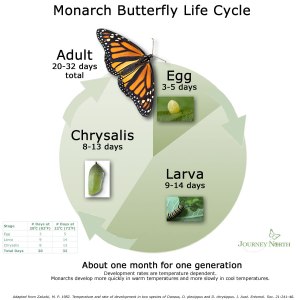I recently showed my children the first episode of Reading Rainbow. The TV show in which a young LeVar Burton encouraged kids to learn and live through reading. And it had a catchy theme song which started with the lyrics: “Butterfly in the sky. I can go twice as high.”
Like many people, I have always been fascinated by butterflies. Watching them flutter around, they always seem so light, happy, and energetic. As a girl, I would sit in the park in the Spring, holding as perfectly still as I could, in hopes that one would land on me.
Has a butterfly ever landed on you?
Butterflies have long been viewed by religions and cultures around the world as a symbol of hope, new beginnings, rebirth.
 After my first miscarriage, a woman in my support group told me that every time she saw a butterfly, she believed it was the soul of her unborn child coming back to check up on her; to tell her that it was ok and that she was going to be ok. Since then, the butterfly, for me, has become a symbol to celebrate my strength, my transformation, my survival. That is why I made the butterfly part of the logo for Empathy Life Coaching.
After my first miscarriage, a woman in my support group told me that every time she saw a butterfly, she believed it was the soul of her unborn child coming back to check up on her; to tell her that it was ok and that she was going to be ok. Since then, the butterfly, for me, has become a symbol to celebrate my strength, my transformation, my survival. That is why I made the butterfly part of the logo for Empathy Life Coaching.
And it makes sense that the butterfly has such reverence across cultures. This peacefully floating insect was once a slinking, garden-destroying caterpillar. And, while I am in no way squeamish of caterpillars, I would not sit in the grass waiting for one to crawl on me.
The caterpillar does all the work but the butterfly gets all the publicity.
-George Carlin
So how does the caterpillar become a butterfly?
Like human newborns, the hatchling caterpillar has one driving instinct: to grow. So it needs to eat. And as it eats and grows, it has to shed its old skin. A caterpillar does this by molting. Hormones in the caterpillar’s body signal its body when it is time to molt. In caterpillar talk, each new stage of a caterpillar’s growth is called an instar. Caterpillars molt 4 times (resulting in 5 instar stages).
Once they enter their last instar stage, the caterpillar starts to build its chrysalis. A hormone called juvenile hormone gets turned off. Without this hormone, the caterpillar’s body can develop imaginal discs (groups of cells that will form the butterfly parts).
But here is the amazing part: In order for these butterfly parts to grow, the caterpillar has to destroy its caterpillar parts. Chemicals in the caterpillar’s muscles, gut, and saliva are released which cause the caterpillar’s cells to self-destruct.
Talk about hitting rock bottom.
A caterpillar is designed to destroy itself before it can transform itself.
If you were to break open a chrysalis during this stage, you would just see an icky, sticky mess! No caterpillar. No butterfly.
Inside the chrysalis, the imaginal disc cells become the building blocks for the butterfly. The material from the destroyed caterpillar cells is used to build the butterfly’s eyes, antennae, legs, wings, etc. The very same DNA is used to create not only two organisms that look very different, but which behave differently too! And the process of the transformation is tightly controlled. There are many steps, and lots of room for error. If the process is altered in any way, the butterfly will not reach its potential. If you try to help the butterfly emerge from its chrysalis early (because, you are just trying to help!), the butterfly will not be able to fly properly.
I’m sure you know where I’m going with this….
What we can learn from the caterpillar’s transformation
After learning more about the science behind a caterpillar’s metamorphosis, I have to say, I am more intrigued by the slinky, hairy work-like insect. George Carlin was right, the caterpillar does do all the hard work and deserves our respect. While I’m not sure this will lead to me letting any caterpillars crawl on me anytime in the near future, here are 5 lessons about caring for ourselves that I have learned from these creatures:
1. Sometimes you have to let yourself completely breakdown before you can pull yourself back together.
2. Transformation is a multi-step process and each step along the way is important and necessary for reaching your full potential.
3. You cannot rush these steps. Each stage is a building block for the next. Only by being patient and gentle with yourself, will you be able to grow your best wings.
4. And these steps take up a large part of the butterfly’s life cycle. While it varies by species, a butterfly spends about 1/2 of its existence going from egg to larva to chyrsalis. Here is the monarch butterfly’s life cycle as an example. In its butterfly form, it lives 20-32 days. But it takes 20-28 days for an egg that was laid to hatch, grow, and transform. So, I guess it makes sense that most humans tend to do most of our transformational growth near mid-life too.

5. A big chunk of the caterpillar’s transformation takes place inside the chrysalis, hidden from the public’s view. While I am a big proponent of making sure you have a supportive and caring network of family and friends by your side, remember that most people will not see the work that you are doing. And may not even be aware that you are doing it.
Ok, I am not joking about this. A light yellow butterfly just fluttered by my window as I was typing that last paragraph. I looked up just in time to see its pretty and peaceful body dart past against a background of green grass and blooming trees. But then I noticed that the branches of the trees are swaying fairly consistently. A reminder that life may not be as calm for that little butterfly as I would like to imagine?
Monarchs, for example, often migrate 700 miles in their lifetime. Sometimes arriving wind-swept and worn on damaged wings.
So here is a bonus lesson I just thought of…
6. Once the butterfly does emerge, the transformation may have ended but the work doesn’t. Just like the butterfly, we, too, will continue to face the elements. We will continue to encounter bumps along the journey.
What the caterpillar calls the end, the butterfly calls the beginning.
-Unknown
come people become moths
LikeLike
true. Sometimes it’s hard to remember though that, while they aren’t as pretty, moths serve a purpose in our lives too.
LikeLike